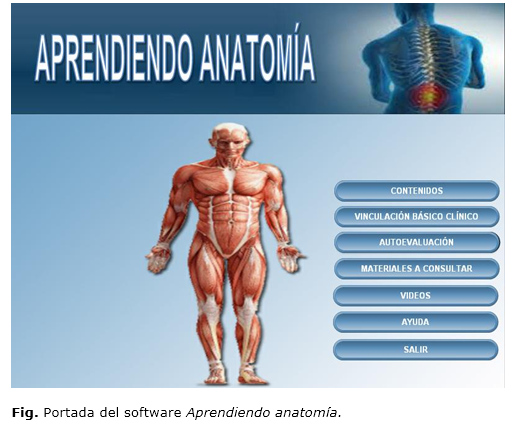Software of the musculoskeletal system
Keywords:
Software, Anatomy, Learning.Abstract
Introduction: the application of Information and Communications Technologies in the teaching-learning process is one of the lines Cuban Health System has drawn in medical-science students. Anatomy is one of the sciences integrating Morphophysiology discipline, and to facilitate its understanding the use of resources and strategies is necessary, among them educational software can be included.Objective: to design a piece of software based on the anatomy of the musculoskeletal system of head and neck for first-year dentistry students of Pinar del Río.
Material and methods: a qualitative study was conducted where dialectical-materialist method was used to achieve the results. For the dialectics of its development process, theoretical-empirical methods along with in-depth study of the subject were considered, as well as type of platform to be used and criteria of specialists. Non-parametric descriptive and inferential statistical techniques were applied to process it.
Results: due to the need of strengthening students’ skills in the use of information and communication technologies, a piece of software for teaching the anatomy of the musculoskeletal system of head and neck was designed: Learning Anatomy through images, videos and texts.
Conclusions: a piece of software is a contribution to the teaching-learning process, which facilitates the independent and self-preparation work by means of the interaction with the content, feedback and evaluation using modern teaching aids, which responds to the acting approach of the future graduate.
Downloads
References
1. Linares Pons N, Verdecia Martínez EY, Álvarez Sánchez EA. Tendencias en el desarrollo de las TIC y su impacto en el campo de la enseñanza. Rev Cubana de Ciencias Informáticas[Internet]. 2014[citado 2014 abr 18]; 8(1):[aprox.9 pantallas]. Disponible en: http://scielo.sld.cu/scielo.php?pid=S2227-18992014000100008&script=sci_arttext
2. Vidal M, Gómez F, Ruiz M. Software educativos. Educ Med Super[internet]. 2010 mar[citado18 abr 2013]; 24(1): [aprox 7 pantallas]. Disponible en: http://scielo.sld.cu/scielo.php?script=sci_arttext&pid=S0864-21412010000100012&lng=es10
3. Ruiz Piedra AM, Gómez Martínez F. Software educativo y principios éticos. Educ Med Super[Internet]. 2013 jun[citado 2014 feb 11] ; 27(2): [Aprox 5 pantallas ]. Disponible en: http://scielo.sld.cu/scielo.php?script=sci_arttext&pid=S0864-21412013000200002&lng=es
4. Muñoz Flores J. El papel fundamental de Internet para el desarrollo de los entornos virtuales de aprendizaje y su impacto en la brecha digital. RMIE[Internet]. 2010[Citado 2013 mar 16]; 15(44): [aprox. 2 pantallas]. Disponible en: http://www.scielo.org.mx/scielo.php?pid=S1405-66662010000100003&script=sci_arttext
5. Díaz E, Martínez V, Ramos Ramírez R. Mirada reflexiva al pensamiento médico educacional del Dr. Fidel Ilizástigui Dupuy. Edumecentro[Internet]. 2011[Citado 2014 mar 16]; 3(3): [aprox. 2 pantallas]. Disponible en: http://dialnet.unirioja.es/servlet/articulo?codigo=3881016
6. Gutiérrez Maydata A, Wong Orfila T, Pérez de Armas A, Fanjul Losada N. Precedencia de contenidos de Morfofisiología en la enseñanza del examen físico en la carrera de Medicina. Rev edumecentro[Internet. 2012[Citado 2015 mar 16]; 4(2): [aprox. 4 pantallas]. Disponible en: http://scielo.sld.cu/scielo.php?pid=S2077-28742012000200004&script=sci_arttext
7. Sartoreto de Oliveira Martins SE, Costi Santarosa LM, Rodríguez DA. Tecnologías de la información y comunicación, TIC, en educación especial[Internet]. Alcalá: Universidad de Alcalá, Servicio de Publicaciones; 2014. Disponible en: http://dialnet.unirioja.es/servlet/libro?codigo=565958 [Citado 11 Nov 2012]
8. Amaro Cano MC. Un nuevo paradigma para la Universidad Nueva. Rev haban cienc méd[Internet]. 2010[citado 2013 nov 11]; 9(1): [aprox.2 pantallas]. Disponible en: http://scielo.sld.cu/scielo.php?script=sci_arttext&pid=S1729-519X2010000100016
9. Celaya Ramírez R, Lozano Martínez F, Ramírez Montoya MS. Apropiación tecnológica en profesores que incorporan recursos educativos abiertos en educación media superior. Revista Mexicana de investigación educativa[Internet]. 2010[Citado 2013 nov 12]; 15(45):[aprox. 3 pantallas]. Disponible en: http://www.scielo.org.mx/scielo.php?pid=S1405-66662010000200007&script=sci_arttext&tlng=pt
10. Rosell Puig W, Domínguez López JC. Importancia y características fundamentales de la literatura docente. Educ Med Super[Internet]. 2010[Citado 2014 mar 16]; 24(3): [aprox. 4 pantallas]. Disponible en: http://scielo.sld.cu/scielo.php?pid=S0864-21412010000300009&script=sci_arttext

Published
How to Cite
Issue
Section
License
Authors who have publications with this journal agree to the following terms: Authors will retain their copyrights and grant the journal the right of first publication of their work, which will be publication of their work, which will be simultaneously subject to the Creative Commons Attribution License (CC-BY-NC 4.0) that allows third parties to share the work as long as its author and first publication in this journal are indicated.
Authors may adopt other non-exclusive license agreements for distribution of the published version of the work (e.g.: deposit it in an institutional telematic archive or publish it in a volume). Likewise, and according to the recommendations of the Medical Sciences Editorial (ECIMED), authors must declare in each article their contribution according to the CRediT taxonomy (contributor roles). This taxonomy includes 14 roles, which can be used to represent the tasks typically performed by contributors in scientific academic production. It should be consulted in monograph) whenever initial publication in this journal is indicated. Authors are allowed and encouraged to disseminate their work through the Internet (e.g., in institutional telematic archives or on their web page) before and during the submission process, which may produce interesting exchanges and increase citations of the published work. (See The effect of open access). https://casrai.org/credit/


